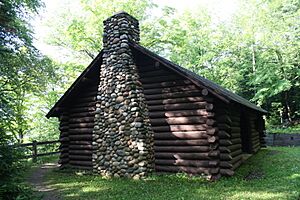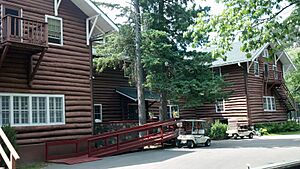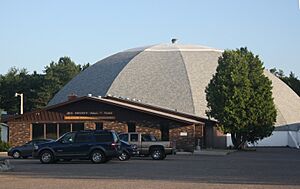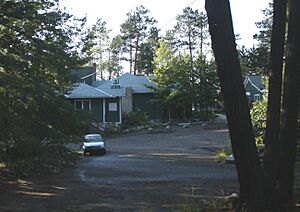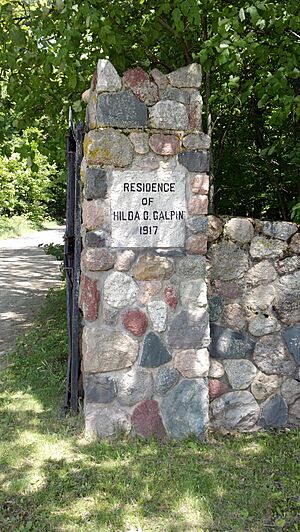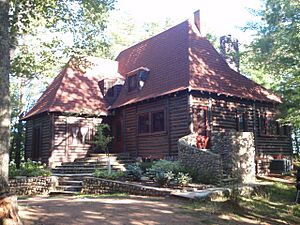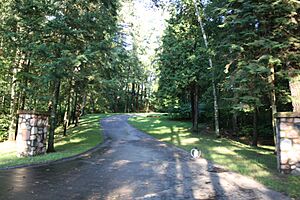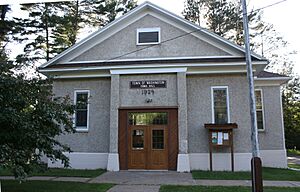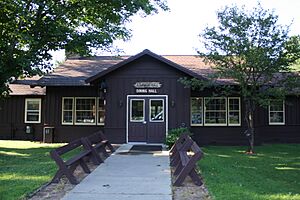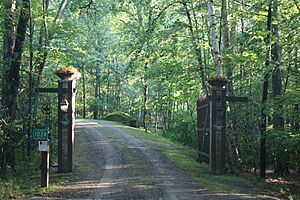National Register of Historic Places listings in Vilas County, Wisconsin facts for kids
Vilas County, Wisconsin, is home to many special places listed on the National Register of Historic Places. This list includes buildings, sites, and areas that are important to the history of the United States. These places are recognized for their unique stories, architecture, or historical events that happened there. In Vilas County, there are 18 such places that are currently listed. One property was once listed but has since been removed.
Contents
- Historic Places in Vilas County
- Anvil Lake Campground Shelter
- Big Sand Lake Club
- Eagle River Stadium
- The Everett Resort
- Fort Eagle
- Government Boarding School at Lac du Flambeau
- Nicolaus H. Hultin House
- Jabodon
- Mayo School
- Peacock Inn (St. Germain, Wisconsin)
- Trees For Tomorrow
- Ben and Margaret Stone Boathouse
- Strawberry Island Site
- Sunset Point (Eagle River, Wisconsin)
- Wallila Farm
- Former Listings
Historic Places in Vilas County
Anvil Lake Campground Shelter
This picnic shelter and bathhouse was built in 1936. It has a rustic style, meaning it looks natural and fits into the forest. It was planned by the United States Forest Service and built by young men from the Civilian Conservation Corps (CCC). The CCC was a program during the Great Depression that helped people find work.
Big Sand Lake Club
The Big Sand Lake Club has been a private resort since 1891. Wealthy people from places like Chicago would come here to relax. The main clubhouse was rebuilt around 1924. It was made from hemlock logs and was considered the largest log building in Wisconsin at the time! The property also has a fish-cleaning house, a manager's house, an ice house, a water tower, and a long dock.
Eagle River Stadium
Built in 1933, the Eagle River Stadium was the very first indoor hockey arena in Wisconsin. Local people worked together to build it, and Charles F. Taylor donated the land. The stadium has a unique dome-shaped roof. Besides hockey, it has hosted boxing matches, circuses, and roller-skating events. Today, it is also home to the Wisconsin Hockey Hall of Fame.
The Everett Resort
The Everett Resort is a large vacation spot located on the chain of lakes near Eagle River. It started welcoming guests in the 1890s. The buildings at the resort show off Craftsman and Rustic architectural styles. In the 1930s, the dining room was big enough to serve 300 guests at once!
Fort Eagle
Fort Eagle is a vacation estate on Big Sand Lake. It belonged to Homer Galpin, who was known for promoting tourism in northern Wisconsin. The estate includes a large mansion, several smaller cottages, and a boathouse. These buildings were constructed between 1919 and 1927. The mansion combines Southern Colonial Revival and Craftsman styles.
Government Boarding School at Lac du Flambeau
This site was once a school where the federal government tried to teach Ojibwe, Potawatomi, and Menominee children new customs and ways of living. This happened from 1895 to 1940. After that, the local tribe took control of the school, and it continued to operate into the 1990s.
Nicolaus H. Hultin House
This unique house was built in 1923. It's a "chateau" (a large country house) with a rustic French Norman style, but it also has some Scandinavian touches. It's located on a peninsula between two lakes. Nicolaus H. Hultin was an immigrant from Sweden who became a successful businessman in Chicago. He built this special retreat in northern Wisconsin.
Jabodon
Jabodon is another vacation estate, located on Cranberry Lake. The main house, built in the Craftsman style, was completed in 1924 for William B. Johnson. Later, in 1937, a Chicago businessman named Abram Pritzker bought the property. He added the "wet boathouse," which allows boats to be stored directly over the water.
Mayo School
The Mayo School was a two-room rural school built in 1924. It has a stucco (a type of plaster) finish on its outside walls. Paul Scharf and M. Sauer were the builders. This old school building now serves as the Town Hall for Washington.
Peacock Inn (St. Germain, Wisconsin)
The Peacock Inn is a rustic tavern and restaurant in northern Wisconsin. It was built in 1930 by Joe Zellner. The building features walls made of peeled logs, giving it a natural, woodsy feel. It also has a chimney made of cobblestones, which adds to its unique charm.
Trees For Tomorrow
This is a group of rustic-style buildings. The oldest one was built in 1937 by the Civilian Conservation Corps (CCC). Until 1942, these buildings were used as a training center for people who managed National Forests. Since 1946, the site has been used as a conference center for an organization called Trees For Tomorrow, which focuses on environmental education.
Ben and Margaret Stone Boathouse
This two-story boathouse is located on Plum Lake. It was built in 1928 in the Craftsman style. Ben Stone worked for several lumber companies in Wisconsin. This boathouse was a part of his property, allowing him to keep his boats right on the lake.
Strawberry Island Site
This site is largely untouched and holds important history. It shows evidence of three different Native American groups living there, with the earliest dating back to 200 BC. The Strawberry Island Site is also very important in the traditional beliefs of the Ojibwe people.
Sunset Point (Eagle River, Wisconsin)
Sunset Point was once the estate of Mont Tennes, a businessman from Chicago. His large home was built in 1928 on Catfish Lake. The house was designed in the French Normandy style, which gives it a grand and historic appearance.
Wallila Farm
The Wallila Farm is a historic farm that dates back to the early 1900s. It was established by Finnish pioneers who settled in the area. This farm represents the early agricultural history and the contributions of Finnish immigrants in Vilas County.
Former Listings
Sometimes, a historic place is removed from the National Register. This can happen if the building is changed too much, or if it is torn down.
Presque Isle State Graded School
The Presque Isle State Graded School was designed in the Art Deco style and built in 1939. However, this school building was demolished by 2001, so it is no longer on the National Register of Historic Places.


